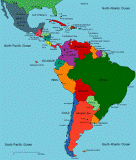Ireland, France, and competitiveness
Thomas Freedman's The End of the Rainbow
How Ireland went from the sick man of Europe to the rich man in less than a generation is an amazing story. It tells you a lot about Europe today: all the innovation is happening on the periphery by those countries embracing globalization in their own ways - Ireland, Britain, Scandinavia and Eastern Europe - while those following the French-German social model are suffering high unemployment and low growth.Ireland's innovation is economic and social:
Ireland's advice is very simple: Make high school and college education free; make your corporate taxes low, simple and transparent; actively seek out global companies; open your economy to competition; speak English; keep your fiscal house in order; and build a consensus around the whole package with labor and management - then hang in there, because there will be bumps in the road - and you, too, can become one of the richest countries in Europe.France's is techonological. But, which makes a country more competitive?
France specializes in huge-scale engineering projects that showcase technology and can only be financed by the taxpayer -- and not only the French taxpayer, but the taxpayers of other, richer countries:
The Concorde, which is now a museum piece, but there might be a son of Concorde in the making.
The Eurotunnel, a.k.a. the chunnel, which is broke to the tune of 6.4billion ($11.5bn; 9.6bn euros).
The bullet trains, which are great.
The Millau Viaduct, financed with EU funds, which presents security issues in this age of terrorism.
The Airbus A380, which is facing delivery delays of six months, even when it wasn't scheduled to go into service for another two years.
Now the ITER fusion reactor is going to France. The BBC has a Q&A: Nuclear fusion reactor page on the project, which is financed by the EU, the US, Japan, Russia, China and South Korea. Australia had opted out of the project
Last year The Economist stated,
On the face of it, that sounds impressive. But even if this trend continues, it will take, according to a report compiled last year by Britain's Parliamentary Office of Science and Technology, until 2043 for fusion to become commercially viable. This forecast is even worse than the traditional 30-year horizon. A doubling every 1.8 years would lead to something like a 4m-fold improvement in performance over four decades. That sounds impressive but, in fact, it shows just how primitive existing fusion technology is. And the analogy with Moore's law is specious for another reason. Even the most primitive computer chips were useful, and found a market. Commercially, fusion is just money down the drain until a reactor that is powerful and reliable enough can be built.Last evening's France2 broadcast optimistically said that Cadarache (the ITER's location) would be the "center of the world", while shedding some light on just how big a gamble this is:
And so fusion advocates are reduced to the last refuge of the desperate engineer—spin-offs. No doubt these would come. Reactors of the ITER design, known as tokamaks (from the Russian for “toroidal magnetic chamber”), look like giant, hollow doughnuts. They work by heating special isotopes of hydrogen contained in the hollow of the doughnut to the point where the electrons and atomic nuclei in the gas part company to create an electrically conducting mixture called a plasma. Further heating speeds the nuclei up to the point where, if they collide, they merge and release the binding energy that will eventually, so the plan goes, be harnessed to make electricity.
Some spin-offs may come from a better understanding of high-temperature plasmas, though they are hard to predict. More plausible spin-offs would be in the field of superconductivity. The electromagnets needed to “confine” the hydrogen while it is heated to fusion temperatures will rely on superconducting wire to feed electricity to them. Superconductivity (which employs a combination of special materials and low temperatures to achieve resistance-free electrical transmission) is another “nearly” technology which has been promising more than it has delivered for many decades. But it is a lot more “nearly” than fusion, and a concerted, technically demanding push in this area might, just, bring it to the point where it could break out of the specialist applications to which it is now confined and contribute to, say, long-distance power transmission.
Whether these spin-offs would justify the price-tag, though, is questionable. If they are worth pursuing, it would surely be better to invest in projects focused on them, rather than hoping they will magically emerge from something else. All in all, ITER seems more boondoggle than boon. Governments should spend their research money on other things.
- the ITER would take 10 years to build, and 20 years of experiements, before it could be decided if any of the technology would be of commercial value.
- The project will not generate electricity; instead it will need massive amounts of energy to heat up.
- It will generate the same amount of nuclear waste as an existing nuclear reactor, but the waste would be shorter-lived.
- The Greens aren't happy about it,as you can read in this article by the Spanish Communist Party (via Hispalibertas), and Greenpeace's press release.
Speaking about the Millau Viaduct, Jacques Chirac said it represented "A modern France, an enterprising, successful France, a France which invests in its future." As for the economy, maybe France should be taking a look at the enterprising, successful modern Ireland, and how Ireland invests in its future.
Also posted at Blogger News Network.










0 Comments:
Post a Comment
<< Home